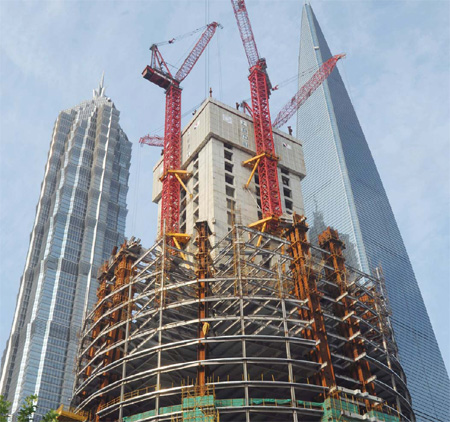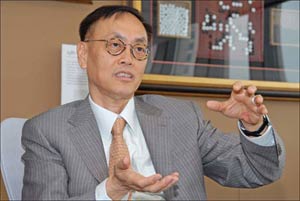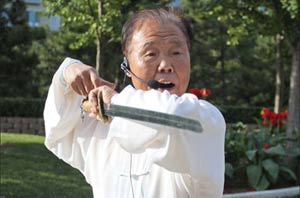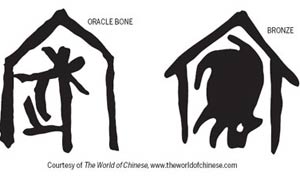Crowning glory
Updated: 2011-10-14 08:46
By Xiao Xiangyi (China Daily)
|
|||||||||
|
China's fast-growing architecture market provides opportunities for foreign architects. Provided to China Daily |
Foreign architects flock to china as new opportunities open up
With over $1 trillion spent last year on new construction projects, up to 48 billion yuan ($7.5 billion, 5.5 euros) spent annually on concept designs and a skyscraper popping up every three days in China, the amount of opportunities for foreign architects are, as one architect put it, beyond comprehension. "In this time of the world, China is the only place that you can work on so many projects. And these projects are usually ridiculously big, which are unimaginable in other places like New York or London," says Casey McSweeney, an American architect at Graft, an international design studio with offices in Beijing, Berlin and Los Angeles. As China gets comfortable in its new spot as the world's second biggest economy, overtaking Japan, it has also become one of the world's most prolific builders.
In the next 50 years, according to calculations by the Financial Times, over 76 percent of China will be urbanized, which will create a major construction market for foreign and domestic architects as well as construction companies.
Capitalizing on the exponential growth in the building market, many foreign architecture firms are opening offices in Beijing and Shanghai. Graft, first founded in the US by German architects, opened its Beijing branch in 2004 and soon after designed The Emperor Hotel, part of the Design Hotels chain on the mainland.
In major Chinese cities, many major projects have been designed by foreign architects, such as the Bird's Nest by Herzog & de Meuron, the China Central Television headquarters in Beijing by OMA's Rem Koolhaas and the Guangzhou Opera House by Zaha Hadid.
Gregor Hoheisel, CEO and founding partner of Graft, says the market for Chinese architecture designs is "humongous".
He says since Graft opened its office here, revenue for the company has nearly doubled from the previous year. He says the number of projects in China has also grown. Up to 30 of Graft's projects for this year are located in China.
Lin Yuru, a senior architect at Graft, says the building boom in China has provided architects numerous opportunities to work on different types of projects at the same time. "This is the best part of the Chinese experience," Lin says.
"China's architecture market is prosperous. I asked one French student why he still chose to major in architecture and he said China has projects," says Mo Tianwei, professor at Tongji University.
Apart from the building boom in metropolises such as Beijing, Shanghai and Guangzhou, China's second- and third-tier cities are also attracting architects.
"The growth in second- and third-tier cities is just massive and many clients go to international architects. The large population, migration of rural communities to the cities, and the desire for the cities to establish identities through architecture are just unique," says Bob Nation, international design principal for the Asia studio at RMJM, an international architecture company founded in the UK.
Massimo Bagnasco, chairman for construction at the European Union Chamber of Commerce in China, says the architecture design market got a big boost when the service sector, which incorporates architecture, was emphasized in China's 12th Five-Year Plan (2011-2015).
But despite the opportunities that China affords, challenges are equally numerous.
Many of the international architectural firms are having to adjust to different requirements and standards of design, says Reja Bakh, design principal at the Shanghai office of Gensler, a major architecture design firm.
"They cannot do the design in the same way as they do in the United States or in Europe. The construction process, the schedule, the culture or value, and the quality are all different," he says.
Bakh says one headache for most foreign architects in China is the incredible rate of construction and the small window of time given to design. A design takes two to three years to hash out in the US, but only two months are usually given for architects to complete a design in a Chinese competition.
"The speed of construction in China is too fast. When you do something very fast, the quality may suffer," Bakh says. "The architecture design is fine, but the quality of construction still needs to be improved. The contracts are okay here, but the builders are not there yet."
Another problem is that many Chinese clients prefer a classic European style, such as chateau-like houses with delicate decorations. Lin at Graft says elegance does not necessarily come from old-fashioned design.
"We do contemporary architecture design. We do not want to copy a European house 1,000 years ago," Lin says.
Foreign architects in China are also not allowed to draw up construction blueprints after the design is finished, according to regulations from the Ministry of Housing and Urban-Rural Development. The rule forces foreign architecture firms to cooperate with Chinese local designing institutes to finish a project.
"We have fantastic cooperation with talented and hardworking Chinese architects," Bakh says.
"To ensure that the original idea can be realized, we have to overcome the separation between the architects, clients and contractors, so we work with the local architects. I see fantastic creative ability in the young architects that are graduating in China. And I hope Chinese architects will play a more important role in Chinese city planning because it matters to the development of the architecture culture of this country," Bob Nation says.
With more foreign designs, however, has come fierce criticism of their concepts. Many critics have leveled Koolhaas' CCTV design as extreme.
But for many foreign architects that China Daily spoke with, the criticism is fine. They see it as a risk that a professional architect must go through in their career.
"Clients are sometimes looking for something unique or extreme. So the opportunity for both Chinese and international architects to experiment is more available here than the rest of the world. To me, criticism is healthy, because it brings about dialogues and debate in the public arena," Nation says.
"Criticism means debate, and debate means attention," says Bagnasco. "Anyway, we have to create a right way to plan the new cities and the green fields. Principles of a sustainable development must be followed."
"This is both unavoidable and beneficial to us. We have to be tolerant and open-minded enough to learn advanced concepts from international architects," says Zhu Xiaodi, president of the Beijing Institute of Architectural Design, a top design institute in China.
Bakh explained that foreign architects must follow their principles to make their works appreciated by Chinese people.
"It is basically a matter of trust. For me, a good building has to be beautiful, to function properly as a building, and also has to make money," Bakh says. "We would explain to our clients whether it is beautiful, functional and profitable. And this is how we bid for the projects."
(China Daily 10/14/2011 page10)










